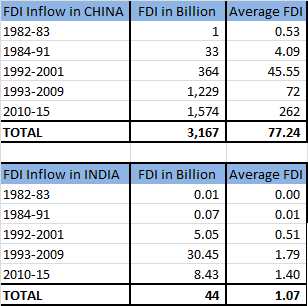INDIAN ECONOMY IN NEED OF A PARADIGM SHIFT
Both India and China although having low productivity per person has been in the top 20 Economies due to their sheer sixe of population and it's impact on both Production & Consumption. While India is more of a consumption economy as far as manufacturing sector is concerned it is a net exported in case of services.
In case of China it is a huge exporter of goods manufactured and basis this has today become the second largest economy in the world .
However both these countries and their citizens still have majority of their population living below the poverty line
The Unemployment Percentage for last years is as follows
In fact the need of the hour is to push Infrastructure and Skill based Export work and utilize the complete human manpower into the same which would not only help them in making their livelihood but also help other industries grow dependent on good Infrastructure and Input industries like Cement , Steel and Project Companies while production . Also Export of Skill based products would help in Forex earnings.
China was able tp push it's growth through FDI push post 1992 and the same needs to be done in India also
The comparative FDI inflows for India and China are as follows
The Indian government also needs to give tax breaks just as given by China then which had prompted NR Chinese based out of Hong Kong being major FDI investors .
There is a big diaspora of Indian NRIs also which needs to be mobilized.
Let us look at what is the Impact of China and India on the overall World Economy
Below is the World Economy Data for Three Milestone Years 1970 , 1990 & 2015 bu-furcated into Top 20 , Next 50 , Bottom 20 , One up 50 and Median 46 Countries.
The below comparison looks at the GDP , Population and how the GDP and Population jointly affects the GDP/capita which is the indicator of how well off the people of that country are subject to inequality of income.
In the Top 20 Bracket GDP has grown by USD 54,614 Billion between 1970 to 2015 and
Population by 1,686 Billion
On Percentage terms it amounts to 2175% & 75 % respectively
The corresponding number for
The Next 50 are USD 11072 & 899
The Middle 46 are USD 1922 and 219
The Last 104 it is USD 2530 and 180
So the maximum growth both for GDP and Population has happened in the Top 20.
If we look at the GDP/Capita it improves substantially for all the years as both India and China which were at a GDP per Capita of USD 110 in 1970 and under 400 in 1995 are even in 2015 at a level of USD 8737 ( China which is 1/6th of USA ) and USD 1974 ( India which is 1/28th of that of USA).
So while these economies are working as consumption economy ( India ) and producing economy ( China ) or Manufacturing and Services based Economy the value addition is happening at a very low end as a result of which the dollars earned per unit of production per man hour is much less as compared to developed countries.
If we look at India's number of USD 2000 it roughly means Rs 50 per hour or 80 cents per hour as against USD 26 dollars in USA.
Even if we look at some of the developing economies like Philippines it is USD 2.5 USD . And the problem is not of low wages but low productivity because if productivity is better the arbitrage will come into play automatically and drive up the rates.
China by investing FDI money into automating it's production units and both my improving productivity as well as adding manpower and capacity to produce more fast has increased its productivity as a result of which China's GDP per Capita which was in 1995 at USD 372 has increased to USD 8700 in 2015 which means an hourly rate of USD 3.5 Dollar which is still lesser than US but much better than earlier.
So to Conclude while China has started the journey it needs to demonstrate that it can sustain the same for next 20-25 years similar to what USA , Germany and Japan has done to become a fully developed economy .
And for India there is a urgent need for productivity improvement and looking at value addition in whatever jobs are being executed which would come from improving the level of education , technology , infrastructure and also efforts should be taken to reduce the in-employment rates.
In case India is unable to grow it's GDP per Capita then the likely scenario would be









Comments